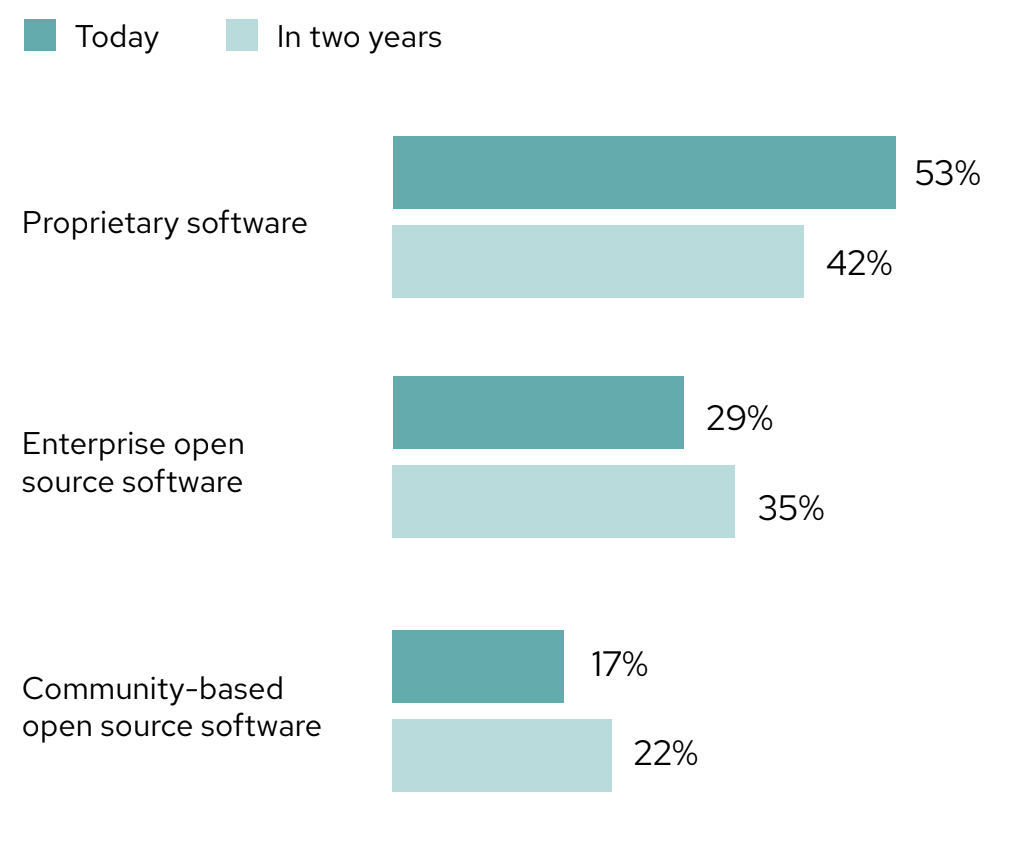Blog Red Hat
Red Hat’s fourth annual The State of Enterprise Open Source report highlights how organizations have adapted to new ways of operating — whether due to external forces or proactive choices — and are selecting methods that provide better competitive advantage.
The report is based on interviews of 1,296 information technology (IT) leaders from 14 countries, presenting an unbiased view of the use of enterprise open source. Respondents stated they have influence over the purchasing decisions within their organization (in app development, app infrastructure, cloud, storage, middleware, server OS or virtualization), and were not informed that Red Hat was the sponsor of the survey. Respondents also needed to be familiar with enterprise open source, and have at least 1% Linux installed at their organizations.
Results indicate that developments originating from open source communities have been and continue to be well-prepared to accommodate the need for agile solutions — now and in the future. As we emerge from the COVID-19 pandemic and look back, we can see how open source projects and open communities contributed to surviving a global crisis, adapting to new ways of living and working, and to accelerating digital transformation of individual businesses and entire industries.
The increasing demand for high quality software, better software security capabilities, lower risk, continuous improvement and flexibility along with lower total cost of ownership (TCO) reinforces what Red Hat has always known — open source is a critical component of modern IT success, and enterprise open source delivers significant business value. Adoption of enterprise open source in business — across all sectors — is no longer an “if”, but a “when and how”.
In our latest report, 95% of respondents say that enterprise open source is important to their organization’s overall enterprise infrastructure. The growth of hybrid cloud adoption and edge computing indicate to us that this percentage will continue to grow and become even more relevant. In this overview, we look at where the report illuminates challenges faced by government entities, where enterprise open source is most relevant to strategy and success in the government sector, and how this aligns with overall technology trends of our North American Public Sector customers.
Highlights from the report within the government sector
Government sector entities are facing many fundamental challenges in IT including cloud adoption, legacy application modernization and new application development followed by continuous integration/continuous delivery (CI/CD) in a DevSecOps environment. These challenges are compounded by the need for workforce transformation to enable government businesses to take true ownership of their IT.

An examination of government sector data — with 79 government IT leaders participating in web based interviews — provides insightful findings regarding the role of open source implementations.
When asked about the top uses of enterprise open source, government sector IT leaders cited the following top four reasons. Containerization leads the list with 61%, followed very closely by application modernization, DevOps, and application development, each at roughly 50%. Collectively, this reveals a heavy focus on fundamental changes in workload deployment, application development methods and system ownership.
As a direct reaction to the immediate challenges associated with an altered operational environment during the pandemic, 78% of IT leaders in government endorsed enterprise open source solutions at a time when flexibility and innovation were needed most.

Many participants identified distinct advantages of using enterprise open source software and tooling, including access to latest technology (76%), flexibility (67%) and simplification in adopting hybrid cloud infrastructure (67%).

Driving the confidence behind these responses among the survey participants is how enterprise open source software is created and delivered in general. Organizations prefer using well-tested enterprise open source code, especially where security updates are well documented, made available promptly and receive broader examination than would be available with proprietary code.
Open source software also “keeps up” with change and executes on the promise of continuous improvement more effectively due to breadth and depth of contribution to design, development and defect correction.
Other findings from government sector
In addition to the top-line findings, we identified a few more trends that are worth exploring from the perspective of government IT leaders.
Enterprise open source continues to gain momentum at the expense of proprietary software
Proprietary software, as a percentage of the software already in use in respondents’ entities, continues to show decline, with a further expected drop of eleven points over the next two years. Migration in usage is increasingly shown to be happening within the enterprise open source category, demonstrating a climb of six points, with community-based open source also increasing five points over the same period.

These trends further reflect the current focus on containerization, application modernization and a clear direction toward more in-house/custom application development and cloud-native applications. In the government sector, this makes sense since government entities have had a more difficult journey adapting to changes forced by the recent pandemic, especially in how they engage “customers”.
Cost and risk are key factors for adoption of open source in government
In response to the query of “What are the top benefits of using enterprise open source?”, “Lower total cost of ownership” was indicated as the top ranking answer (38%). A related benefit that contributes to TCO — enterprise level support — was also expressed as a key factor (27%).

Clearly, when there is no revenue/profit gain to be had by adopting open source, cost remains a key factor for both acquisition and operations. This bodes well for the success of digital modernization and growth in the government sector as TCO becomes a driver for adopting and scaling other IT capabilities and emerging technologies.
Government entities often budget for and maintain applications and IT systems for much longer than commercial businesses, which tends to increase TCO and risk in proprietary software. Feedback from the government sector indicates that they have recognized these issues and see enterprise open source as critical for addressing many fundamental concerns at least in part.
The other top two benefits expressed by government IT leaders are likewise linked to each other — better security (26%) and safe adoption/reduced risk (30%). Overall, government sector IT leaders appear more conservative about digital modernization than their commercial sector counterparts.
Government sector IT leaders expect to increase their use of enterprise open source software for emerging technologies
The mindset associated with enterprise open source has trended in an ever more favorable light with 71% of government sector IT leaders indicating that they have a more positive perception of enterprise open source than just a year ago.
Some of this positivity is possibly due to enterprise open source contributions to solving pandemic related change, and the flexibility and timeliness of the open source approach gets spotlighted in such situations. As a result, 69% of government sector IT leaders expect to increase the use of enterprise open source to enable more rapid, flexible and lower risk adoption of emerging technologies.


Organizations that responded are utilizing enterprise open source solutions and technologies in a large number of relatively new software categories, including containers, container orchestration and cloud-native open source projects. To us, these results indicate that enterprise open source continues to grow and is showing no signs of slowing down.
Government sector is “different”
One of the more significant take-aways from The State of Enterprise Open Source report is that the governmental sector is substantially different from other (i.e., commercial) sectors. Among the top four benefits expressed by government sector IT leaders, two of them — lower total cost of ownership and access to enterprise level support — were not indicated in the top four of any other sector. Strategic plans and roadmaps in the government sector have a more distant horizon and a more deliberate journey.
Case in point — despite the heavy emphasis on security in the government sector and regulated industries at large, the primary concerns expressed on the surface are relatively basic. This gives enterprise open source solutions an advantage due to the inherently adaptable nature of open source and the depth of support available to succeed in applying open source for highly customized purposes. By virtue of late adoption and the build up of significant support services in industry, government entities may benefit more rapidly from applications of enterprise open source.
Thinking outside the [report]
Up to this point, the take-aways from the Red Hat report are mostly obvious, but let’s consider what the data does not say directly. Consider that the top four uses are 50-60% of aggregate responses, and the top four benefits are less than 40%. That leaves a lot of space below the top four.
All of the other responses must be (a) different from the top four and (b) widely variable. That finding might be the most interesting of all. We can see that the government sector was — at the time of the survey — focused on fundamentals. But we can also see that there is wide variation in both the applications of enterprise open source and the perceived benefits of enterprise open source in the government sector.
How may this shift the future of enterprise open source? The typical evolution of thought leadership behind any given technology begins with the creators, then transitions to the early adopters and innovators and eventually to the late adopters.
Given that the government sector is traditionally slower to adopt new IT technology than commercial sectors, they have the benefit of assessing the successes and failures of the early adopters and, as mentioned previously, the benefit of mature consulting and support services. In this case, that’s a (very) good thing because in today’s world, IT failures can have catastrophic fallout, and the last thing anyone needs is for their government entities (local, regional or national) to crash and burn.
Fortunately, over the past few years, the government sector has begun taking the lead in thought leadership on some key digital modernization areas such as adoption of zero trust security, supply chain risk management and integrity, oversight of critical infrastructure, strategic data exploitation and (at least across the US federal government) unified customer experience (CX). Generally speaking, governmental entities have been more sensitized to these issues as a result of the numerous high profile security breaches and ransomware exploits over the past several years, and these events are expected to continue and increase over time.
Enterprise open source and the open model can contribute significantly to national and global safety, security, stability and continuity due to the diverse breadth and depth of contribution, inherent application flexibility and the rapid evolution and continuous improvement of open source software.
Explore further
Intrigued enough to gain even more insights on enterprise open source in the government sector? You can find them in The State of Enterprise Open Source: Government Sector Infographic, or we invite you to explore the full The State of Enterprise Open Source report.
Interested in how Red Hat enables open source solutions in the government sector? Visit www.redhat.com/gov to learn more.
À propos de l'auteur
Craig Heartwell leads the Chief Architects team in the public sector for North America at Red Hat, which is responsible for strategic alignment with customer mission and enabling customer success in adoption of open source technology and solutions. Heartwell brings more than 36 years of professional experience in technology, strategy and leadership that spans domains as diverse as weapon systems diagnostics, simulation based training & wargaming, information security, intelligent video surveillance, aerial & satellite reconnaissance, and healthcare.

